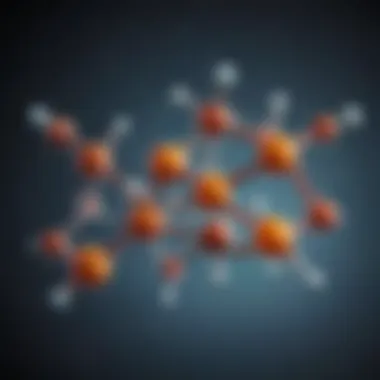The Role of TPA in Cancer Research and Signaling


Intro
The exploration of biochemical compounds is fundamental in molecular biology. Among these compounds, 12-O-tetradecanoylphorbol 13-acetate (TPA) stands out due to its significant role in cancer research and cell signaling pathways. TPA is notably a synthetic analog of diacylglycerol, which has implications for understanding tumor promotion and the intricate mechanisms of cellular functions.
In the following sections, we will delve into various aspects of TPA, highlighting its mechanisms of action, relevant experimental applications, and recent discoveries that shed light on its role in cancer biology. An emphasis will be placed on ensuring clarity, making the information accessible for students, educators, researchers, and professionals.
Research Highlights
Key Findings
The investigations surrounding TPA have revealed several key findings:
- TPA activates protein kinase C (PKC), leading to alterations in cellular signaling that can promote cell growth and proliferation.
- It is linked to increased expression of oncogenes and transcription factors that drive malignant transformation in cells.
- Recent studies indicate that TPA can induce apoptosis in certain cancer types under specific conditions, showcasing a duality in its effects.
- Its capacity as a tumor promoter has been established consistently in various animal models, emphasizing its importance in cancer research.
"12-O-tetradecanoylphorbol 13-acetate is not just a compound of interest but a pivotal player in deciphering the complexities of cancer biology."
Implications and Applications
The implications of TPA’s effects are profound for both research and therapeutic applications:
- Cancer Research: TPA serves as a tool for investigating mechanisms of tumor promotion and progression, aiding in the discovery of novel therapeutic interventions.
- Signaling Pathway Analysis: It is utilized to study pathways associated with PKC, enhancing our understanding of cell signaling in health and disease.
- Potential Therapeutics: Understanding TPA's dual role can lead to the development of targeted therapies that exploit its apoptotic properties in cancer treatment.
Methodology Overview
Research Design
To study TPA’s effects, a variety of research designs are employed:
- In vitro studies utilizing cancer cell lines to assess TPA's role in promoting growth or inducing apoptosis.
- In vivo studies in animal models to observe the tumor-promoting effects of TPA and related mechanisms.
- Molecular assays to investigate the activation of PKC and subsequent signaling events triggered by TPA.
Experimental Procedures
Researchers conduct carefully designed experiments that include:
- Cell Culture: Growing specific cancer cell lines in a controlled environment to assess the effects of TPA.
- Western Blotting: A technique to quantify protein expression levels affected by TPA treatment, particularly focusing on PKC pathway components.
- Apoptosis Assays: Evaluating the capacity of TPA to induce cellular death through various methods, including flow cytometry and staining techniques.
Through these methodologies, a comprehensive understanding of TPA in molecular biology can be achieved, establishing its significance in both academic research and potential clinical applications.
Prologue to 12-O-Tetradecanoylphorbol 13-Acetate
12-O-Tetradecanoylphorbol 13-acetate, often abbreviated as TPA, is widely recognized as an influential compound in the field of molecular biology. It is a synthetic derivative of phorbol and mimics the action of diacylglycerol, a lipid that plays a vital role in various cell signaling pathways. Understanding TPA is essential for researchers and educators because of its role in promoting cell proliferation and tumor formation. Its mechanisms of action provide insights that can inform cancer research and therapeutic strategies.
TPA serves multiple purposes in scientific studies. It is most prominently used to analyze signal transduction pathways, making it a prominent tool in cancer research. By studying TPA, researchers can explore how normal cellular functions are altered during tumor promotion, thereby contributing to the knowledge necessary for developing cancer treatments. The chemical also presents several pathways that are pivotal in the study of pharmacology, toxicology, and tissue engineering.
Chemical Structure and Properties
The chemical formula of 12-O-tetradecanoylphorbol 13-acetate is C214O5. This compound contains a phorbol core structure with a tetradecanoyl side chain at position 12 and an acetate moiety at position 13. The unique arrangement of these functional groups induces its biological activity.
TPA is a lipophilic molecule, which facilitates its interaction with cellular membranes. Its solubility in organic solvents allows scientists to perform various in vitro experiments. When dissolved, it can effectively penetrate cell membranes, leading to critical cellular responses. The specific chemical properties of TPA enable researchers to manipulate and assess cellular responses in controlled laboratory conditions.
Historical Context and Discovery


The discovery of 12-O-tetradecanoylphorbol 13-acetate dates back to the early 1970s. It was initially derived from the seeds of the Croton tiglium plant. Research highlighted TPA’s potency as a tumor promoter in rodents, particularly when administered in conjunction with carcinogens. This led to widespread interest among scientists to delineate its biological effects and underlying mechanisms.
Over the subsequent decades, TPA has undergone extensive investigation, revealing its role in activating protein kinase C, a key player in cell signaling pathways. This transformative research has not only advanced our understanding of cancer biology but has also led to the identification of additional pathways connected to inflammation and cell growth.
In summary, the exploration of 12-O-tetradecanoylphorbol 13-acetate remains crucial in the realms of cancer research and signaling studies. The insights gained through TPA research are impactful and continue to shape the direction of molecular biology.
Mechanisms of Action
Understanding the mechanisms of action of 12-O-tetradecanoylphorbol 13-acetate (TPA) is crucial for grasping its role in molecular biology. This compound functions primarily as a tumor promoter and operates through several biochemical pathways. These pathways significantly influence both normal cellular processes and pathological states, particularly cancer. Insights into these mechanisms can guide future experimental approaches and therapeutic innovations.
Role in Cell Signaling
Cell signaling is fundamental for cells to communicate and respond to external stimuli. TPA mimics diacylglycerol (DAG), a natural component in cell membranes crucial for activating certain signaling pathways. By binding to receptors, TPA initiates a cascade of cellular events that eventually lead to various biological effects. This stimulation can result in cell proliferation, differentiation, and survival, but it can also contribute to oncogenesis.
The activation of the protein kinase C (PKC) family is a pivotal aspect of TPA's signaling role. PKC enzymes play essential roles in several cellular functions, including metabolism, cell cycle regulation, and apoptosis. TPA's ability to activate these kinases underscores its importance in understanding cellular signaling's complexities. The connection between TPA action and cell signaling mechanisms reveals how external influences can dictate internal cellular outcomes, often with significant implications for tumor biology.
Activation of Protein Kinase
The activation of protein kinase C by TPA is a key focus in cancer research and molecular biology. When TPA binds to cellular membranes, it causes the translocation of PKC isoforms from the cytosol to the membrane. This process leads to PKC activation, which in turn modulates various downstream signaling pathways.
Different PKC isoforms have distinct pathways and roles, affecting diverse biological processes. For example, PKC can influence pathways involved in apoptosis, cell growth, and even innate immune responses. These actions highlight the dual nature of PKC; while it can promote healthy cellular functions, its dysregulation often links to tumor progression and metastasis.
Research indicates that prolonged or aberrant PKC activation can contribute to oncogenic transformations in cells. This connection presents TPA as not only a tool for studying PKC functions but also a potential therapeutic target in malignancies characterized by PKC misregulation.
Influence on Gene Expression
TPA also plays a substantial role in modulating gene expression. The activation of protein kinase C subsequently triggers mitogen-activated protein kinase (MAPK) pathways. These pathways are instrumental in the regulation of transcription factors that control gene expression. Genes influenced by TPA include those involved in cell cycle progression, inflammation, and cell survival.
By impacting gene expression, TPA can induce pro-inflammatory cytokines, which may lead to a tumor-promoting microenvironment. Moreover, TPA can enhance the expression of oncogenes while repressing tumor suppressor genes, further contributing to carcinogenic processes. Understanding how TPA modulates gene expression is crucial for developing effective strategies in cancer treatment and diagnostics.
"TPA acts not just as a tumor promoter but as a molecular tool, revealing critical insights into cell signaling pathways that govern cellular behavior."
In summary, the mechanisms of action of TPA provide a detailed map of how this compound influences cell signaling, PKC activation, and gene expression. These processes are interconnected and underscore the significance of TPA in both research and potential therapeutic contexts.
TPA in Cancer Research
12-O-tetradecanoylphorbol 13-acetate (TPA) plays a profound role in cancer research, chiefly due to its ability to promote tumor formation and enhance understanding of cancer biology at the molecular level. This section will discuss the tumor promotion mechanisms associated with TPA as well as the insights derived from cellular transformation studies. Both elements highlight TPA's significance as a tool in exploring malignant processes and testing therapeutic approaches.
Tumor Promotion Mechanisms
TPA primarily functions through its interaction with Protein Kinase C (PKC), a family of enzymes involved in several cellular signaling pathways. When TPA binds to PKC, it activates multiple downstream effects, which can contribute to tumor promotion. Some key mechanisms include:
- Cell Proliferation: TPA stimulates cell division in various types of cells. This increased proliferation can result in the accumulation of mutations, thus fostering tumorigenesis.
- Inhibition of Apoptosis: By altering apoptotic pathways, TPA can prevent programmed cell death, allowing abnormal cells to survive and proliferate.
- Promotion of Angiogenesis: TPA has been linked to the process of angiogenesis, which is the development of new blood vessels necessary for tumor growth.
Overall, these tumor promotion mechanisms underscore TPA's significance in modeling cancer processes and testing anti-cancer drugs.
Cellular Transformation Studies
The transformation of cells refers to a process where normal cells acquire characteristics of cancerous cells, such as unregulated growth and invasive properties. TPA has been extensively utilized in laboratory settings to study this transformation. Some important points include:
- Assessment of Oncogenesis: TPA serves as an effective agent to induce cellular transformation in various model systems, thereby providing insights into oncogenic processes.
- Testing Therapeutics: Researchers use TPA-induced models to test the effectiveness of cancer therapeutics, enabling the study of their potential to reverse or inhibit transformation.
- Molecular Insights: Cellular analysis post-TPA treatment allows for the identification of genetic and molecular alterations that accompany transformation, refining our understanding of cancer progression.
"The ability of TPA to mimic tumor-promoting activities makes it a valuable research tool for understanding the complexities of cancer biology."


In summary, TPA's role in cancer research is multi-faceted. It not only provides essential mechanisms for understanding tumor promotion but also serves as a platform for investigating potential therapeutic strategies. As research continues, the insights gained from TPA-related studies will likely further illuminate the intricate relationship between cellular signaling and cancer development.
Experimental Applications
The section on experimental applications is crucial for understanding how 12-O-tetradecanoylphorbol 13-acetate (TPA) is utilized in various research contexts. TPA's unique properties allow researchers to explore its effects on cellular processes, signaling pathways, and potential therapeutic applications. This section will cover both in vitro and in vivo studies, each providing distinct insights into TPA's functional mechanisms and implications for molecular biology.
In Vitro Studies
In vitro studies offer a controlled environment for examining the specific effects of TPA on cultured cells. These studies focus on cellular mechanisms which can lead to significant findings in cancer research and cell signaling contexts. TPA is commonly used to differentiate between various cell types, especially in studies examining the role of protein kinase C.
Some key points regarding in vitro applications of TPA include:
- Cell Signaling Studies: TPA can stimulate signaling pathways related to cell growth and differentiation. By examining these pathways, researchers can gain insight into tumorigenesis.
- Drug Testing: In vitro systems allow for efficient screening of potential anti-cancer agents. The modulation of TPA on cultured tumor cells helps identify drug efficacy and mechanisms.
- Molecular Pathways Investigation: Study of how TPA interacts and regulates other molecular pathways enhances understanding of cancer biology. This can lead to discovery of novel targets for therapies.
Overall, in vitro studies using TPA provide a fundamental understanding needed to explore new treatments or insights in cancer biology, allowing a detailed observation of cellular behavior under controlled settings.
In Vivo Studies
In vivo studies are indispensable for adapting findings from in vitro assays to whole organisms. TPA is used in rodent models primarily to study tumor promotion effects and to analyze the broader physiological responses. The application of TPA in living organisms provides context that is often missed in isolated cell cultures.
Key aspects of in vivo applications include:
- Tumor Promotion Models: Researchers can observe tumor development and progression in response to TPA treatment. This helps illustrate the tumor-promoting potential of TPA in live biological systems.
- Systemic Effects: Understanding the systemic biological impacts of TPA is critical for evaluating its toxicity and efficacy. System-wide responses can reveal how treatments might affect human health.
- Therapeutic Investigations: Utilizing TPA in drug development phases showcases its dual nature; both as a tool for studying tumor promotion and as a means of investigating potential prevention methods.
In summary, in vivo studies are necessary for translating laboratory discoveries into clinical relevance. By understanding TPA's multifaceted role in a living system, researchers can better inform strategies for cancer prevention and treatment.
"In vitro and in vivo studies together create a comprehensive understanding of TPA's role in molecular biology. They highlight its potential in both basic and applied research endeavors."
These experimental applications of TPA not only demonstrate its significance in scientific inquiry but also underpin its value in furthering cancer research and therapeutic development.
Controversies and Challenges
The exploration of 12-O-tetradecanoylphorbol 13-acetate is not without its controversies and challenges. Understanding these aspects is crucial for anyone involved in molecular biology and cancer research. As TPA is known for its potent tumor-promoting properties, discussions about its safety and toxicity are pervasive. Moreover, regulatory perspectives surrounding the use of TPA in laboratory settings or clinical trials present distinct challenges that must be navigated with care.
Safety and Toxicity Concerns
One of the most pressing issues related to TPA is its safety profile. Its role as a tumor promoter raises significant concerns among researchers and healthcare practitioners. Experiments have shown that TPA can lead to neoplastic transformation in various cell types, suggesting its potential to drive tumorigenesis. Long-term exposure to TPA, even at low concentrations, may lead to various adverse effects, thereby complicating its application in ongoing research.
To mitigate these risks, it is essential to adopt rigorous safety guidelines while conducting experiments involving TPA. Specific protocols need to be established to protect researchers from its toxic effects. Researchers must also be trained to recognize and respond to potential toxicity, ensuring that experimental designs prioritize the safety of personnel and subjects alike.
"The dual role of TPA as a valuable research tool and a potential biological hazard makes its handling a matter of utmost importance."
Regulatory Perspectives
Regulatory frameworks governing the use of TPA are also points of contention. Due to its classification as a hazardous substance, institutions must adhere to strict regulations when considering TPA for research purposes. These regulations can include meticulous documentation, compliance with safety standards, and regular inspections. This bureaucratic oversight, while aiming to ensure safe practices, can sometimes obstruct timely research outputs.
Researchers often find the complexity of regulatory processes burdensome. Access to TPA may be restricted due to the hazards associated with its use. Therefore, scientists must stay informed about changing regulations. Collaborative efforts between regulatory bodies and the scientific community are essential to streamline processes while ensuring safety and effectiveness in experiments.
In summary, the controversies and challenges surrounding 12-O-tetradecanoylphorbol 13-acetate illustrate the necessity for a balanced approach. While it is an indispensable tool in molecular biology research, its safe and regulated use is paramount.
Recent Advances in Research


Recent advances in research on 12-O-tetradecanoylphorbol 13-acetate (TPA) provide significant insights into its multifaceted role in molecular biology. As a crucial player in cell signaling pathways, TPA has been the focus of numerous studies aimed at unraveling its mechanisms of action, particularly in the context of cancer. These advances open new avenues for understanding cellular processes and potential therapeutic targets.
Discoveries in Molecular Pathways
The exploration of TPA’s role in various molecular pathways has led to critical discoveries. Researchers have uncovered how TPA influences mitogen-activated protein kinase pathways, fundamentally altering cell proliferation and survival. These pathways are intricately linked to cancer development, making the understanding of TPA's mechanisms vital for targeted interventions.
Recent studies have shown that TPA activates specific protein kinase C (PKC) isoforms, which modulate downstream signaling cascades. This activation not only promotes tumor growth but also induces differentiation in certain cell types. Here are some key points regarding these molecular pathways:
- PKC Activation: TPA is known to selectively activate different PKC isoforms, which have varied roles in cellular processes. The isoform-dependent effects underscore the complexity of TPA's action in cancer biology.
- Cell Cycle Regulation: New findings indicate that TPA affects key regulators of the cell cycle, thereby contributing to abnormal cell division, a hallmark of cancer.
- Epigenetic Modifications: There is emerging evidence that TPA may induce epigenetic changes that alter gene expression patterns, further reinforcing its role in tumor promotion.
"Understanding TPA's influence on molecular pathways presents opportunities for novel therapeutic strategies in oncology."
Developments in Therapeutic Applications
Developments in the therapeutic applications of TPA continue to shape the landscape of cancer treatment. TPA's unique properties have led to innovative approaches incorporating it into therapeutic regimens. Here are notable developments:
- Targeted Therapy Research: Ongoing studies are investigating the potential of using TPA-like compounds to selectively target cancer cells while reducing toxicity in normal tissues. This strategy aims to enhance efficacy in treatment.
- Combination Therapies: Researchers are examining the effectiveness of combining TPA with established chemotherapeutic agents. Such combinations may amplify the anti-tumor effects while potentially mitigating resistance that can occur with monotherapy.
- Novel Delivery Systems: Advancements in drug delivery systems are being explored with TPA to improve bioavailability and targeting. Nanoparticle systems, for instance, are designed to deliver TPA directly to tumor sites, increasing its therapeutic impact.
Future Perspectives
The exploration of 12-O-tetradecanoylphorbol 13-acetate (TPA) continues to unfold as a critical area of research in molecular biology. This section examines the future perspectives of TPA, focusing on two key aspects: research directions and the potential for clinical use. Understanding these aspects is essential for harnessing the full benefits of TPA in both fundamental and applied sciences.
Research Directions
Future research on TPA must prioritize delineating the molecular mechanisms underlying its effects in various biological contexts. Specifically, studies should aim to clarify the role of TPA in different signaling pathways. Such investigations can yield insights that connect TPA’s action with specific oncogenic processes. With advancements in technology, researchers now have better tools to observe real-time interactions in cells, which may improve our understanding of TPA's functionality.
Additionally, identifying potential biomarkers of TPA response is vital. This could help detect whether certain cell types are more susceptible to its effects. Such progress could inform future therapeutic strategies designed to leverage TPA's mechanisms in controlling cell proliferation and differentiation.
Moreover, interdisciplinary collaboration is likely to accelerate discoveries. Integrating findings from molecular biology, biochemistry, chemoinformatics, and clinical medicine can help develop a more nuanced understanding of TPA. The collaborative effort may also facilitate the translation of findings into clinical applications, ultimately improving patient outcomes in cancer treatment.
Potential for Clinical Use
The therapeutic potential of TPA is promising, but it requires careful consideration. Clinical applications should aim to utilize TPA's capacity to modulate signaling pathways that are often dysregulated in cancer. However, the benefits must be weighed against its known tumor-promoting effects. Hence, a targeted approach is essential.
TPA could be advantageous in therapies designed for specific cancer subtypes that exhibit particular vulnerabilities to its signaling properties. For instance, utilizing TPA in combination therapies may help sensitize resistant cancer cells to conventional treatments. Furthermore, its role as an adjuvant therapy warrants further investigation.
Importantly, ongoing research must ensure safety and efficacy before any clinical application. Conducting rigorous clinical trials will be essential. These trials must not only focus on treatment outcomes but also examine long-term effects and surveillance post-therapy.
End
The conclusion of this article serves as a crucial synthesis of the examination of 12-O-tetradecanoylphorbol 13-acetate (TPA). It underscores the significance of understanding this compound, not only in the context of molecular biology but also in its broader implications for cancer research. This section reiterates the essential elements discussed throughout the article, highlighting the tremendous benefits associated with TPA's role in cell signaling, gene expression, and tumor promotion.
Summary of Key Points
In summarizing the key points, it is important to draw attention to the multifaceted nature of TPA.
- Chemical Structure: TPA is a diacylglycerol analog, which is essential in its interaction with protein kinase C.
- Mechanisms of Action: It influences cell signaling pathways that promote tumorigenesis.
- Cancer Research: TPA facilitates the understanding of cancer promotion mechanisms, allowing researchers to explore potential therapeutic targets.
- Experimental Applications: Both in vitro and in vivo studies have outlined TPA's role in cellular transformation and tumor promotion.
- Controversies: Discussions on safety and regulatory challenges highlight the complexities surrounding TPA's use in research.
These points illustrate the critical facets of TPA, providing a foundation for its ongoing investigation and application in various domains.
Final Thoughts on TPA in Research
As the field of molecular biology evolves, the importance of compounds like TPA cannot be overstated. Its role as a tool for understanding cancer mechanisms and the intricate cellular processes offers a pathway for potential therapeutic advancements. Future research should focus on addressing the safety concerns associated with TPA while maximizing its utility as a research tool.
TPA's impact on protein kinase C and its involvement in tumor promotion present not just challenges, but also opportunities in the development of targeted therapies.
"Understanding TPA’s mechanisms can lead to innovative approaches in cancer treatment and prevention."
Overall, the exploration of TPA is essential for scientists, educators, and students alike, as it enables a deeper comprehension of cellular dynamics and cancer pathology. Engaging with this knowledge paves the way for future breakthroughs in molecular biology, emphasizing the relevance of this compound in advancing our understanding of disease mechanisms.



